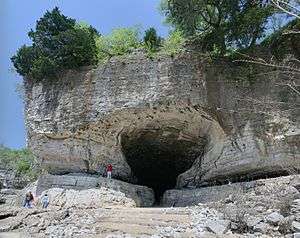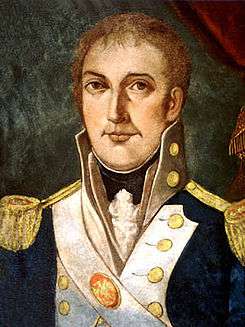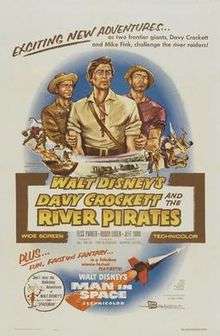Samuel Mason
| Samuel Mason | |
|---|---|
 Following his military service, in the American Revolutionary War, Samuel Mason led a gang of river pirates, from 1797-1799, on the Ohio River, at the infamous outlaw haunt of Cave-in-Rock. | |
| Born |
Samuel Ross Mason November 8, 1739 Norfolk, Colony of Virginia |
| Died |
1803 (aged 64) Jefferson County, Mississippi Territory |
| Cause of death | gunshot wound or murder by tomahawk |
| Nationality | American |
| Occupation | horse thief, soldier, state militia officer, frontiersman, tavern keeper, burglar, bandit, justice of the peace, criminal gang leader, river pirate |
| Known for | Being a Patriot, Revolutionary War soldier, and a ruthless outlaw |
| Spouse(s) | Rosanna or Rosannah Dorsey |
| Children | 9 |
Samuel Ross Mason also, spelled Meason (1739–1803) was a Virginia militia captain, on the American western frontier, during the Revolutionary War, who following the war became the leader of a gang of river pirates and highwaymen on the lower Ohio River and the Mississippi River in the late 18th and early 19th centuries. He was associated with outlaws around Red Banks, Cave-in-Rock, Stack Island, and the Natchez Trace.
Early life
Mason was born in Norfolk, Virginia, and raised in what is now Charles Town, West Virginia, formerly a part of Virginia.
Horse thievery
Samuel Mason was thought to have been "born bad." According to Lyman Draper, in the 1750s Mason got his earliest start in crime as a teenager, by stealing the horses of Colonel John L. Hite, in Frederick County, Virginia, being wounded and caught by his pursuers.[1] He moved from Charles Town to what is now Ohio County, West Virginia, also at that time a part of Virginia, in 1773.
Revolutionary War service in Virginia and Pennsylvania
During the American Revolution, Samuel Mason was a captain, of the Ohio County Militia, Virginia State Forces. According to Ohio County court minutes, dated 7 January 1777, Mason was recommended to the governor of Virginia to serve as captain of the militia.[2] On 28 January, he was present and cited as a captain from Ohio county at a "council of war" held at Catfish Camp.[3] Catfish Camp was located at or near present-day Washington, Pennsylvania. On 8 June 1777, Mason wrote a letter from Fort Henry, now present-day Wheeling, West Virginia, to brigadier general Edward Hand, at Fort Pitt, now present-day Pittsburgh, Pennsylvania. The letter he wrote was signed Samuel Meason.[4] On September 1, 1777, Captain Mason was wounded but survived an ambush by Native Americans, near Fort Henry. Most of the men in his Virginia Militia company perished during the attack.[5]
Honest pursuits
Samuel Mason moved again, in 1779, to a part of Virginia that is now present-day Washington County, Pennsylvania, where he was elected justice of the peace and later selected as an associate judge, leaving for an area that was then a part of Virginia and now the present-day State of Kentucky, in 1784. Mason's surname was spelled interchangeably as Meason in many of the early frontier records. This is explained in two family histories of the Mason/Meason family, Pioneer Period and Pioneer People of Fairfield County, Ohio by C. M. L. Wiseman, dated 1901, and Torrence and Allied Families by Robert M. Torrence, dated 1938.
Criminal gang leader in Red Banks, Kentucky and at Cave-In-Rock, Northwest Territory
In the early 1790s, Samuel Mason moved his family to the Red Banks on the Ohio River, now present-day Henderson, Kentucky, where he began his full-time criminal activities. He later settled downriver on Diamond Island and engaged in river piracy. By 1797, Mason moved the base of his operations further downriver to Cave-in-Rock on the Illinois side of the river in the Northwest Territory. The Mason Gang of river pirates openly based themselves at the prominent Ohio River landmark known as Cave-in-Rock, a huge shelter cave. Samuel Mason had a brief association with the first known serial killers in America, Micajah and Wiley Harpe, as well as Peter Alston, and possibly John Duff, the counterfeiter. Mason and his gang stayed at Cave-In-Rock until the summer of 1799, when they were expelled by the "Exterminators", a group of regulators under the leadership of Captain Young of Mercer County, Kentucky. Samuel Mason moved his operations down the Mississippi River and settled his family in Spanish Louisiana Territory, how the present-day state of Missouri, and became a highwayman along the Natchez Trace in Mississippi Territory, now the present-day state of Mississippi. It was on the Natchez Trace that Mason received his most infamous nickname. He would leave a message after each crime (often in the blood of his murdered victims) proudly stating, "Done by Mason of the Woods". In April 1802, Mississippi Territorial Governor William C. C. Claiborne was informed that Mason and Wiley Harpe had attempted to board the boat of a Colonel Joshua Baker between Yazoo, now present-day Yazoo, Mississippi, and Walnut Hills, now present-day Vicksburg, Mississippi.[6]
Arrest, escape, and death
According to Spanish colonial court records, Spanish government officials arrested Samuel Mason and his men, early in 1803, at the Little Prairie settlement, now present-day Caruthersville, in southeastern Missouri. Mason and his gang, including his family members, were taken to the Spanish colonial government in New Madrid, Spanish Upper Louisiana Territory, along the Mississippi River, where a three-day hearing was held to determine whether Mason was truly involved in river piracy, as he had been formally accused of this crime. Although he claimed he was simply a farmer, who had been maligned by his enemies, the peculiar presence of $7,000 in currency and twenty human scalps found in his baggage was the damming evidence that convinced the Spanish he indeed was a river pirate. Mason and his family were taken, under armed guard, to New Orleans, the capital of Spanish Lower Louisiana Territory, where the Spanish colonial governor ordered them handed over to the American authorities in the Mississippi Territory, as all crimes they had been convicted of appeared to have taken place in American territory or against American river boats.
While being transported up the Mississippi River, Samuel Mason and gang members John Sutton or Setton, one of the many aliases used by Wiley Harpe, and James May, alias of Peter Alston, overpowered their guards and escaped, with Mason being shot in the head during the escape. Although one of the 1803 accounts {Rothert .p. 247} claimed Captain Robert McCoy, the commandant of New Madrid, who in their escape was killed by Mason, but actually died in 1840, was neither crippled or killed, by Mason.[7] American territorial governor Claibourne, immediately issued a reward for their recapture, prompting Wiley Harpe and another man, James May, the alias used by Peter Alston, to bring Mason's head, in an attempt to claim the reward money, whether they killed Mason or whether he died from his wound suffered in the escape attempt has never been established. Setton and May were recognized and identified as wanted criminals, Wiley Harpe and Peter Alston were arrested, tried in U.S. federal court, found guilty of piracy, and hanged in Old Greenville, Jefferson County, Mississippi Territory in early 1804.[8]
Image gallery
-
"Springdale", in Frederick County, Virginia, was built in 1753 and was the home of Colonel John L. Hite. A teenage Samuel Mason stole the horses of Colonel Hite and was later pursued, wounded, and captured, but because of his young age, he was not punished any further.
-

Fort Henry, formerly in Pennsylvania, now present-day West Virginia, in 1777, at the time, Captain Samuel Mason was wounded and survived, an ambush, by Native Americans. Most of the men, in Samuel Mason's Company, perished, during the attack.
-

While on the Ohio River and later the Mississippi, Samuel Mason and his gang of river pirates, chose flatboats, keelboats, and rafts, as profitable targets, to attack, because of the valuable and plentiful cargo on board.
-

The old path of the "Natchez Trace", where, between 1799-1803, Samuel Mason and the Mason Gang committed highway robbery and murder, against helpless and unsuspecting travelers and were reported, as crimes done by "Mason of the Woods"
-
The Samuel Mason Gang was captured, in 1803, and brought before the Spanish Territorial commandant, Colonel Robert McCoy, in New Madrid, Spanish Upper Louisiana Territory, New Spain The courtroom would have been a small, simple, structure similar to the Old Cahokia Courthouse, in Cahokia, Illinois Country, Northwest Territory.
-
When the members, of the Samuel Mason Gang, received their hearing, in the Spanish colonial court, of New Madrid, the frontier courtroom may not have been much bigger, than a typical courtroom interior, as was found in the Old Cahokia Courthouse.
-

In 1803, Mississippi Territorial governor, William C. C. Claiborne, offered a $2,000 reward, a very large sum of money, at the time, for the capture or severed head of Samuel Mason.
-

The fun, romanticized, Hollywood version, of Samuel Mason and his gang, of Cave-In-Rock river pirates, from the 1956 Walt Disney film, Davy Crockett and the River Pirates.
-

The 1962 film, How the West Was Won, A Mason-like, frontier, outlaw leader, of a gang of river pirate, was portrayed by Walter Brennan, as the fictional character of "Colonel Jeb Hawkins", which alluded to the historical Cave-In-Rock.
See also
- Peter Alston
- James Ford (pirate)
- John Murrell (bandit)
- piracy
- Stack Island (Mississippi River)
- Tower Rock
References
- ↑ Rothert's 1924 "The Outlaws of Cave-In-Rock...".p. 164 1924
- ↑ Boyd Crumrine, Virginia Court Records in Southwestern Pennsylvania, Records of the District of West Augusta and Ohio and Yahogania Counties, Virginia, 1775–1780, Consolidated Edition, p. 366, dated 1981.
- ↑ History of the Upper Ohio Valley, Vol. 1., Brant & Fuller, p. 73, dated 1891.
- ↑ Samuel Hazard, Pennsylvania Archives, Selected and Arranged from Original Documents in the Office of the Secretary of the Commonwealth, Conformably to Acts of the General Assembly, February 15, 1851, & March 7, 1852, Vol. V., p. 445, dated 1853.
- ↑ History of the Upper Ohio Valley, Vol. 1., Brant & Fuller, pps. 80–82, dated 1891.
- ↑ D. Roland's 1907 "Mississippi, comprising Sketchs of Towns, Events...".p. 176 1907
- ↑ Houck's "History of Missouri from the Earliest explorations..." 1908 Volume 2 .p.140. According to Conrad's "Encyclopedia of the History of Missouri" 1901 .p. 557 a Creek named Tewanaye who killed a David Trotter in New Madrid in 1802 had been found guilty of murder in New Orleans and in a return trip near Natchez in a galley Tewanaye had tried to escape and crippled McCoy; Tewanaye was executed in New Madrid January 3, 1803.
- ↑ Wagner, Mark and Mary R. McCorvie, "Going to See the Varmint: Piracy in Myth and Reality on the Ohio River, 1785–1830", In X Marks The Spot: The Archaeology of Piracy, edited by Russell K. Skowronek and Charles R. Ewen, pp. 219–247. University of Florida Press, Gainesville.
- Asbury, Herbert. The French Quarter: The Informal of the New Orleans Underworld
- Crumrine, Boyd. Virginia Court Records in Southwestern Pennsylvania: Records of the District of West Augusta and Ohio and Yohogania Counties, Virginia, 1775–1780. Publisher Genealogical Publishing Com, 1902. ISBN 0806306246, 9780806306247
- Magee, M. Juliette. Cavern of crime. Livingston Ledger, 1973.
- Rothert, Otto A. The Outlaws of Cave-In-Rock. Cleveland: 1924; rpt. 1996 ISBN 0-8093-2034-7
- Seineke, Kathrine Wagner. The George Rogers Clark adventure in the Illinois: and selected documents of the American Revolution at the frontier posts Polyanthos, 1981.
- Thrapp, Dan L. Encyclopedia of frontier biography, Volume 4, Arthur H. Clark Co., 1988
- Wagner, Mark and Mary McCorvie. "Going to See the Varmint: Piracy in Myth and Reality on the Ohio and Mississippi Rivers, 1785–1830," X Marks the Spot: The Archaeology of Piracy, Univ. Press of Florida, 2006.
- Wellman, Paul I. Spawn of evil: the invisible empire of soulless men which for a generation held the Nation in a spell of terror. New York: Doubleday, 1964.
External links
- Bell Anthology – Samuel Mason
- Sam Mason survives Indian attack, This Day in History, History.Com
- Mason and Harpe
- Outlaws of Cave-In-Rock, Southern Illinois History Page
- Samuel Mason, X Marks the Spot: The Archaeology of Piracy, by Mark Wagner, Book Review, Southern Illinois University, Carbondale
- Samuel Mason and Little Harpe, Mississippi Local History Network
- Outlaws, Rascals & Ruffians,! Mississippi Local History Network
- Samuel Mason at Cave-in-Rock
